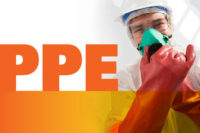
OK, so you realize that respiratory protection is needed for a given job, but how do you know which respirator is correct? The following criteria will help when it comes to selecting the proper protection.
1) Inspect the facility for potential air contaminants
Conduct a thorough inspection and evaluation of the facility identifying areas where workers may be exposed to harmful dusts, fogs, fumes, mists, gases, smokes, sprays, vapors or oxygen-deficient environments. A person experienced in workplace safety and health, typically the safety manager, should perform this inspection. Search for areas where there are:- Visible particulates being generated. Pay particularly close attention to areas that may have asbestos, extensive mold contamination, excessive dust and/or areas where silica (sand/concrete) may be present.
- Volatile liquids being handled in open containers — parts cleaners, spray finishing, painting, washing, transfer and sample points.
- Gases being released from operations — pressure relief points, tank hatch openings or gas transfer connection/disconnection points.
- Operations that may involve burning materials — furnaces, engine exhausts or high temperature process areas.
- People working in or near oxygen-deficient or excessive environments — sumps, manholes, tanks or pits.
2) Use engineering/administrative controls
After locating sources of potential contaminants, control worker exposures through engineering or administrative methods. Engineering controls may involve installing ventilation systems, using water sprays to contain dusts, enclosing volatile liquid generation point areas, tightening up material transfer systems, and so on. Administrative controls may involve limiting worker time in a hazardous area or changing to less toxic/volatile substances.When controlling worker exposures is not possible, or while controls are being implemented, respirator protection may be needed.
3) Determine worker exposures
Make a reasonable estimate of each worker’s exposure potential. OSHA’s Respiratory Protection Advisor Web site offers a guide that can help with this task. Review the “Exposure Assessment — When? What? How Much?†atwww.osha.gov/SLTC/etools/respiratory/haz_expose/haz_expose.html.4) Conduct workplace air monitoring
The preferred method of quantifying a worker’s exposure is to conduct air monitoring. Typically, this is done by contracting with a Certified Industrial Hygienist. Compare the worker exposure level to the permissible exposure limit (PEL) and the maximum exposure level (TWA) for the air contaminant. Another option would be to study the operation and use MSDSs (material safety data sheets), previous experience and professional judgment to make the determination if respiratory protection is needed. When using this approach, apply a large safety factor to compensate for errors in judgment.
5) Consult respirator manufacturer
Respirators are selected according to the air contaminant concentration in the worker’s breathing zone, the physiological work the worker must do, the conditions under which the respirator will be used, and so on. Consult a respirator manufacturer or safety and health professional for guidance on selecting the proper respirator. Certain operations require supplied air respirators, such as:- IDLH (Immediately Dangerous to Life or Health) exposures;
- Firefighting;
- Emergency situations;
- Oxygen deficient/rich environments;
- When an estimate of worker exposures is unknown.
- OSHA PEL (Permissible Exposure Limit);
- ACGIH TLV (American Conference of Governmental Industrial Hygienists Threshold Limit Value); or
- NIOSH REL (National Institute for Occupational Safety and Health Recommended Exposure Limit).
As an example, let’s assume workplace air sampling indicates TWA (Time Weighted Average) exposures were 30 ppm for benzene. The OSHA PEL TWA for benzene is 1 ppm TWA. Next, use OSHA’s new assigned protection factor (APF) table below to obtain the APF for a particular style respirator.
The APF is the level of respiratory protection that a respirator, or class of respirators, is expected to provide to workers when an effective respiratory protection program is in place.
The maximum use concentration (MUC) that a half mask respirator will provide is calculated by multiplying the OSHA PEL of the substance by the APF for the respirator type. OSHA PEL x APF = MUC
For the example above:
- 1 ppm OSHA PEL x 10 APF for half mask = 10 ppm the Maximum Use Concentration
This is less than 30 ppm, so a half mask will not work. - 1 ppm OSHA PEL x 50 APF for full face = 50 ppm the Maximum Use Concentration
A full face air purifying respirator could be used in this situation.
6) Respirator cartridge determination
A respirator cartridge must be carefully selected. The length of time a respirator cartridge is effective in removing contaminants is dependent on several factors, including:- The air contaminant(s);
- The concentration of the air contaminant(s);
- The amount of work the wearer is performing;
- Respiratory cartridge variability;
- The relative humidity, work area temperature, etc.
Air Contaminant: Benzene
Breathing rate: Moderate
Temperature: 70°F
Humidity: < 65%
Breakthrough: Calculated at 10%
Safety Factor: None
Estimated cartridge service life: 9.6 hours
Remember, cartridge respirators cannot be in atmospheres above a substance’s IDLH, which for benzene is 500 ppm. The IDLH concentration is typically listed in the respirator manufacturer’s cartridge service life program.
Choosing the right respirator and cartridge combination is critical to protecting worker health. If you are unsure, have questions or do not feel qualified to select a respirator and cartridge, contact a Certified Industrial Hygienist (CIH) or a respirator manufacturer’s representative for assistance.



